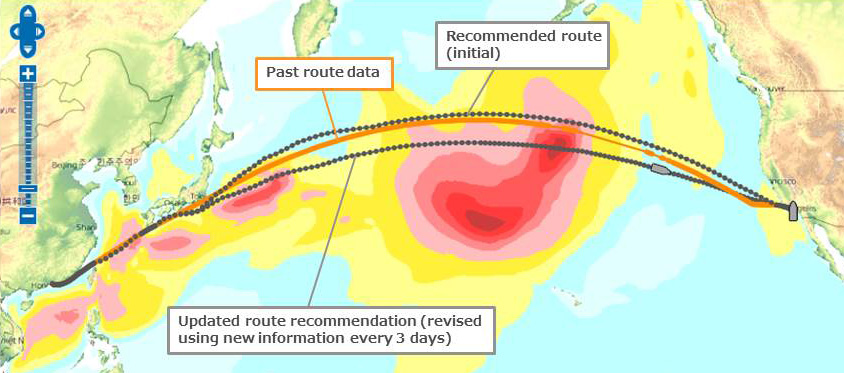"K" Line Orders New Optimum Weather Routing System
Sep. 26, 2017
Tokyo, September 26, 2017 — Kawasaki Heavy Industries, Ltd. announced today its receipt of an order from Kawasaki Kisen Kaisha, Ltd. ("K" Line) for a newly developed optimum weather routing system to be installed on approximately 120 vessels. This system displays proposals for routes that use minimal fuel amounts while taking consideration of ship safety. "K" Line plans to deploy the new system as a comprehensive ship operation and performance management system on all of its vessels by 2021.
In developing the optimum weather routing system, Kawasaki conducted onboard verification tests using a wide range of ships with the cooperation of "K" Line. The validity of the test results were assessed based on knowledge provided by "K" Line regarding ship operation. "K" Line has been impressed by the system's precision in predicting the roll, pitch and fuel consumption amounts for its selected routes compared with data on past operations, which is why the company has decided to introduce this system on approximately 120 of its ships.
Advantages of the Optimum Weather Routing System
- 1)
- Proposes optimized routes to the destination requiring the lowest-possible fuel amounts, based on ship movement models accounting for ship performance characteristics (hull resistance and ship motions) in response to actual conditions experienced in real-life sea environments, while also taking consideration of wave heights and directions, wind directions and speeds, and oceanic current movements provided by marine weather forecasts.
- 2)
- Predicts ship roll and pitch to select routes while taking full consideration of ship safety.
- 3)
- Capable of providing optimal sea route selection support based on ship type. Users can select optimal routes by specifying the arrival date and time, in response to which the system will calculate a route requiring the least amount of fuel, or by specifying the main engine output or RPM, in response to which the system will determine an arrival date based on the route requiring the least fuel.
- 4)
- Route proposals can be set to account for fuel consumption in controlled sea zones including ECAs*1 and SECAs*2 as well as areas to be avoided due to shoals, piracy, and other such factors.
With the aim of offering safer passage and greater cost savings through its optimum weather routing system, the Kawasaki Group strives to utilize the synergy achieved among the wide range of technologies it has developed to further improve precision. In this way, Kawasaki will contribute toward advancements in the marine shipping industry.
*1 Emission Control Areas: zones where restrictions apply on nitrogen oxide (NOx), sulfur oxide (SOx) and particulate matter emissions from ships.
*2 SOx Emission Control Areas: zones where restrictions apply on sulfur oxide (SOx) emissions from ships.






